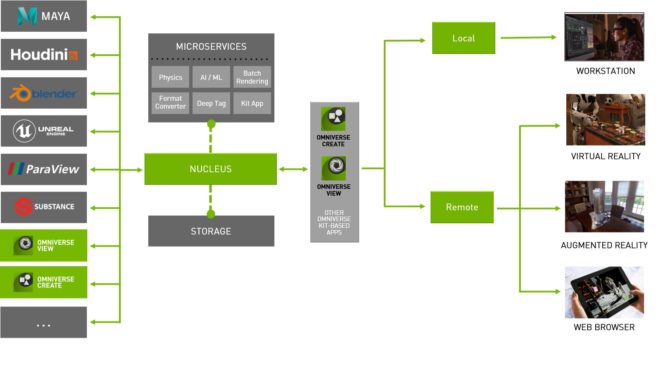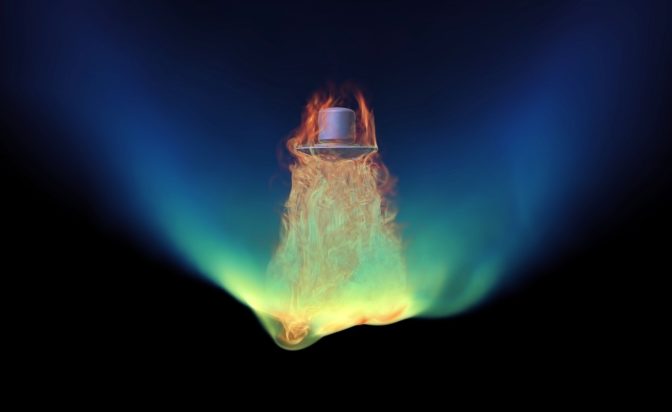Whether helping the world understand our most immediate threats, like COVID-19, or seeing the future of landing humans on Mars, researchers are increasingly leaning on scientific visualization to analyze, understand and extract scientific insights.
With large-scale simulations generating tens or even hundreds of terabytes of data, and with team members dispersed around the globe, researchers need tools that can both enhance these visualizations and help them work simultaneously across different high performance computing systems.
NVIDIA Omniverse is a real-time collaboration platform that lets users share 2D and 3D simulation data in universal scene description (USD) format from their preferred content creation and visualization applications. Global teams can use Omniverse to view, interact with and update the same dataset with a live connection, making collaboration truly interactive.
Omniverse ParaView Connector
The platform has expanded to address the scientific visualization community and now includes a connector to ParaView, one of the world’s most popular scientific visualization applications. Researchers use ParaView on their local workstations or on HPC systems to analyze large datasets for a variety of domains, including astrophysics, climate and weather, fluid dynamics and structural analysis.
With the availability of the Omniverse ParaView Connector, announced at GTC21, researchers can boost their productivity and speed their discoveries. Large datasets no longer need to be downloaded and exchanged, and colleagues can get instantaneous feedback as Omniverse users can work in the same workspace in the cloud.

Users can upload their USD format data to the Omniverse Nucleus DB from various application connectors, including the ParaView Connector. The clients then connect to the Omniverse Kit and take advantage of:
- Photorealistic visuals – Users can leverage a variety of core NVIDIA technologies such as real-time ray tracing, photorealistic materials, depth of field, and advanced lighting and shading through the Omniverse platform’s components such as Omniverse RTX Renderer. This enables researchers to better visualize and understand the results of their simulations leading to deeper insights.
- Access to high-end visualization tools – Omniverse users can open and interact with USD files through a variety of popular applications like SideFX Houdini, Autodesk Maya and NVIDIA IndeX. See documentation on how to work with various applications in Omniverse to maximize analysis.
- Interactivity at scale – Analyzing part of a dataset at a time through batched renderings is time-consuming. And traditional applications are too slow to render features like ray tracing, soft shadows and depth of field in real time, which are required for a fast and uninterrupted analysis. Now, users can intuitively interact with entire datasets in their original resolution at high frame rates for better and faster discoveries.
NVIDIA IndeX provides interactive visualization for large-scale volumetric data, allowing users to zoom in on the smallest details for any timestep in real time. With IndeX soon coming to Omniverse, users will be able to take advantage of both technologies for better and faster scientific analysis. This GTC session will go over what researchers can unlock when IndeX connects to Omniverse.

- Real-time collaboration – Omniverse simplifies workflows by eliminating the need to download data on different systems. It also increases productivity by allowing researchers on different systems to visualize, analyze and modify the same data at the same time.
- Publish cinematic visuals – Outreach is an essential part of scientific publications. With high-end rendering tools on the Omniverse platform, researchers and artists can interact in real time to transform their work into cinematic visuals that are easy for wide audiences to understand.
“Traditionally, scientists generate visualizations that are useful for data analysis, but are not always aesthetic and straightforward to understand by a broader audience,” said Brad Carvey, an Emmy and Addy Award-winning visualization research engineer at Sandia National Labs. “To generate a range of visualizations, I use ParaView, Houdini FX, Substance Painter, Photoshop and other applications. Omniverse allows me to use all of these tools, interactively, to create what I call ‘impactful visualizations.’”
Learn More from Omniverse Experts
Attend the following GTC sessions to dive deeper into the features and benefits of Omniverse and the ParaView connector:
- Cinematic Scientific Visualization with the Omniverse ParaView Connector – Peter Messmer – HPC DevTech – NVIDIA (S32572)
- Real-Time, High-Fidelity Visual Experience of Large-Scale Scientific Simulations in Omniverse Using NVIDIA IndeX – Marc Nienhaus, Jeorg Mensmann – Software Engineering – NVIDIA (S32064)
Get Started Today
The Omniverse Paraview connector is available now. Download Omniverse open beta here to test it out, and check out some of our content within the scientific visualization playlist from GTC 21.
